The following is an excerpt from AMC’s Mountain Skills Manual.

Not all knots are the same and knowing the right one to use at the right time can make your outdoor adventure a success.
Once you have found the perfect site for your camp, you have the task of putting together your tent or sleeping shelter. Before you set up, it is essential to know a few knot-tying skills that will help you when you’re getting your camp ready. Ropes are perhaps the most versatile piece of gear you carry in your backpack. They can help you build a shelter, negotiate difficult terrain, protect your food against opportunistic wildlife, repair equipment, or be used in a first-aid situation. But a rope alone is not useful if you don’t know how to use it. First of all, it is essential to understand that not all knots are the same, although all knots belong to a few families. These families are:
- Stopper. A knot designed to prevent the end of a rope from slipping through a hole.
- Loop. A knot designed to secure part of a rope to an object.
- Hitch. A knot designed to secure part of a rope to an object by cinching the rope around that object.
- Bend. A knot designed to join two ends of a rope to each other. The ends can be from the same rope or from two different ropes.
You might not realize it, but ropes have different parts with specific names. There are even names for the way the rope is folded. For instance, the part of a rope held in your hand is referred to as the running end, while the rest of the rope is known as the standing end. When a rope’s running end is folded along the standing end, this part of the rope is known as the bight. Finally, when the running end crosses the standing end, the rope is said to be a loop.
An overhand knot is perhaps the easiest knot to tie and to remember. Simply take the running end of the rope, make a loop, and pass the running end through the backside of the loop. There you have it! You just made a stopper knot called an overhand. This classic pretzel-shaped knot is one of the first most people learn, and it would be the first knot a beginner would tie if someone handed them a rope and said, “Tie a knot.” We’ll look at three families in this chapter, loop, hitch, and bend.
LOOP FAMILY
Overhand on a Bight
Similar to the overhand knot, this knot is performed with a bight. Begin by creating a bight, which will be known as the running end. Use the running end bight to make a loop, then pass the running end through the backside of the loop, and pull until the knot is taut. You now have a loop known as an overhand on a bight.
This knot does not have to be tied at the end of a rope so it is useful in many different situations. You can clip a carabiner to it to quickly connect it to another object—such as a food bag in a bearproof food system.
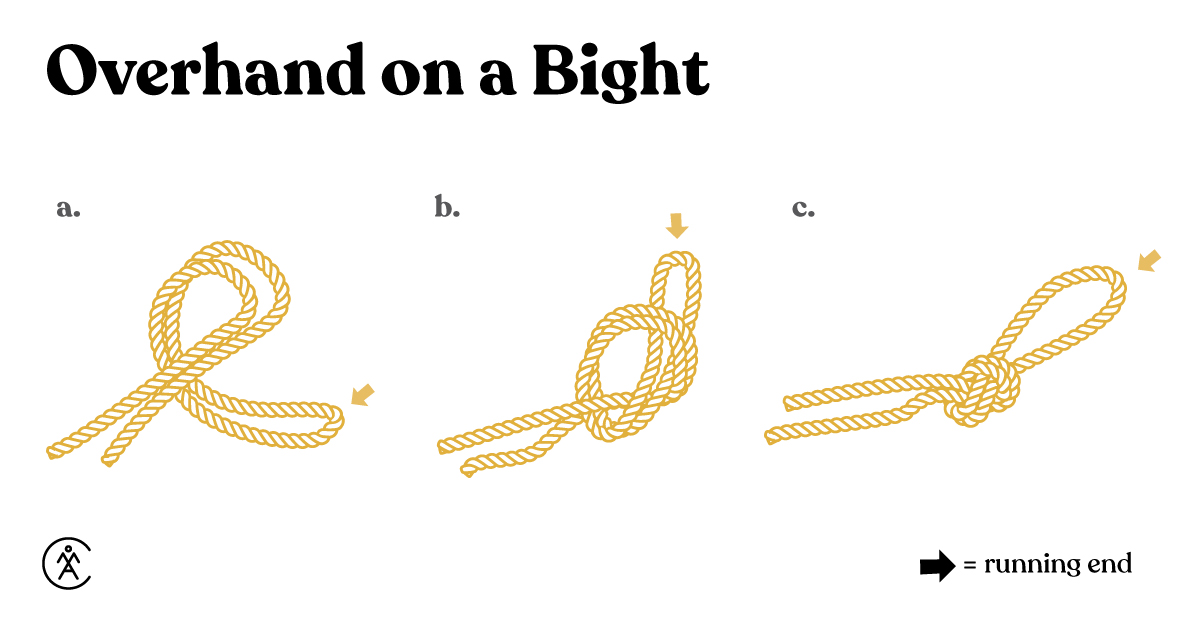

Bowline
The bowline is perhaps the most popular camping knot, as well as the most difficult to learn. Do not try to tie this knot without using an anchor point to tie the knot to—tying this knot to an imaginary object will only confuse you. Second, unless you want to learn to tie this knot to yourself, always face the object you want to tie the bowline to. Knot-tying is hands-on learning and must be done in the exact context you’ll use the skill. To tie a bowline:
- Facing an anchor point such as a small tree, pass the running end of the rope around the tree from right to left.
- Make a loop on the standing end of the rope; this will be the rope that is on the right side of the tree. The loop you make must have two characteristics: It should be pointing toward the running end, which is on the left side of the tree; and the long, standing end of the rope should be on the bottom of the loop, meaning that when you make the loop, the rope should loop itself as if it were spiraling down to the ground.
- While holding the loop with your right hand, feed the running end through the loop coming upward through the loop. (Note in this setup, going through the loop in a downward path with the running end will lead to failure and frustration.)
- Feed the running end of the rope along the left side of the standing end, go under the standing end, and return inside the loop in a downward motion.
- Pull the running end and the standing end away from each other, and you will see the knot form.
The bowline is a popular knot because it creates a loop knot around an object, thus securing one end of the rope to that object. The most important characteristic of the bowline is that it can be put under a lot of tension and still be easy to undo by flipping its loop—very useful when setting up a shelter, such as the ridgeline of a tarp.
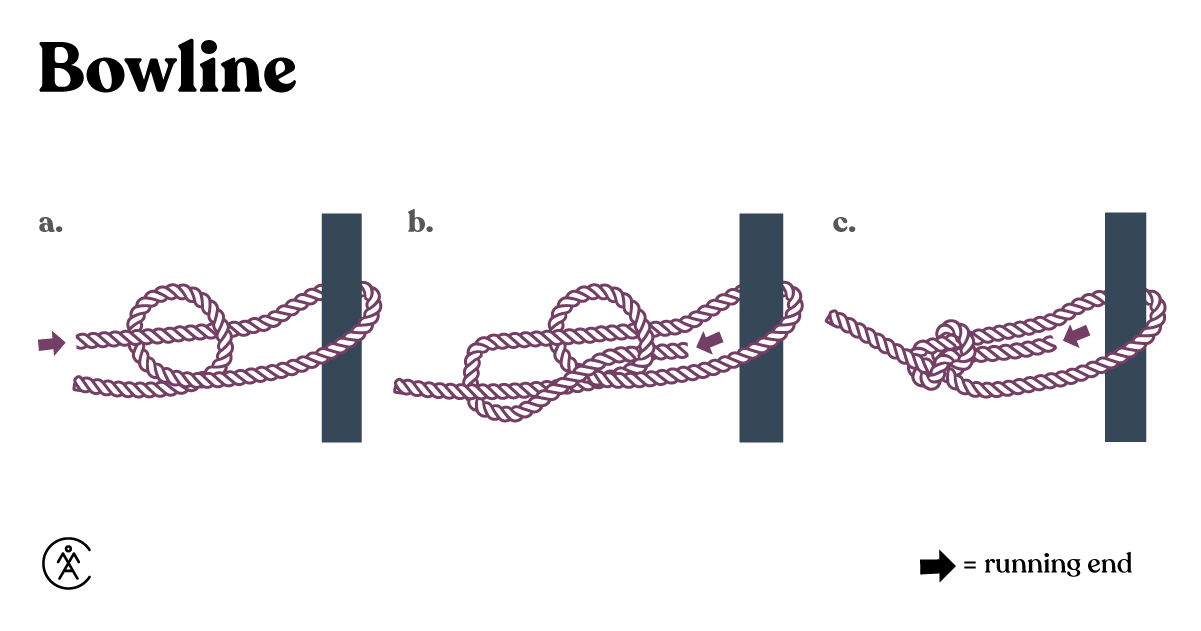

HITCH FAMILY
Trucker’s Hitch
The trucker’s hitch is a compound knot that functions as a kind of pulley, giving you a 3 to 1 mechanical advantage (meaning the puller can pull three times his or her weight), although rope-on-rope friction might reduce this to 1.5 to 1. Nevertheless, the trucker’s hitch is quite effective at creating tension on a rope, such as when setting up a shelter.
Note: Make sure that one end of the rope is already secured to an anchor point, or attached to a tarp or tent fly, and that tension can be created when completing the trucker’s hitch.
- While facing a small tree, begin this knot by passing the running end of the rope around a tree, feeding the rope from right to left.
- On the standing end of the rope, make a loop through which you pass a bight of rope taken from the rope between the loop and the tree. Pull on the bight until the slip knot is formed. The knot you just created is known as a marlin spike hitch.
- Pass the running end of the rope that went around the tree through the bight and pull the running end toward the tree. You can now apply a lot of tension to the rope.
- Complete the knot by forming a slippery half hitch (see Figure 39 on page 186) in the running end against the tip of the bight.
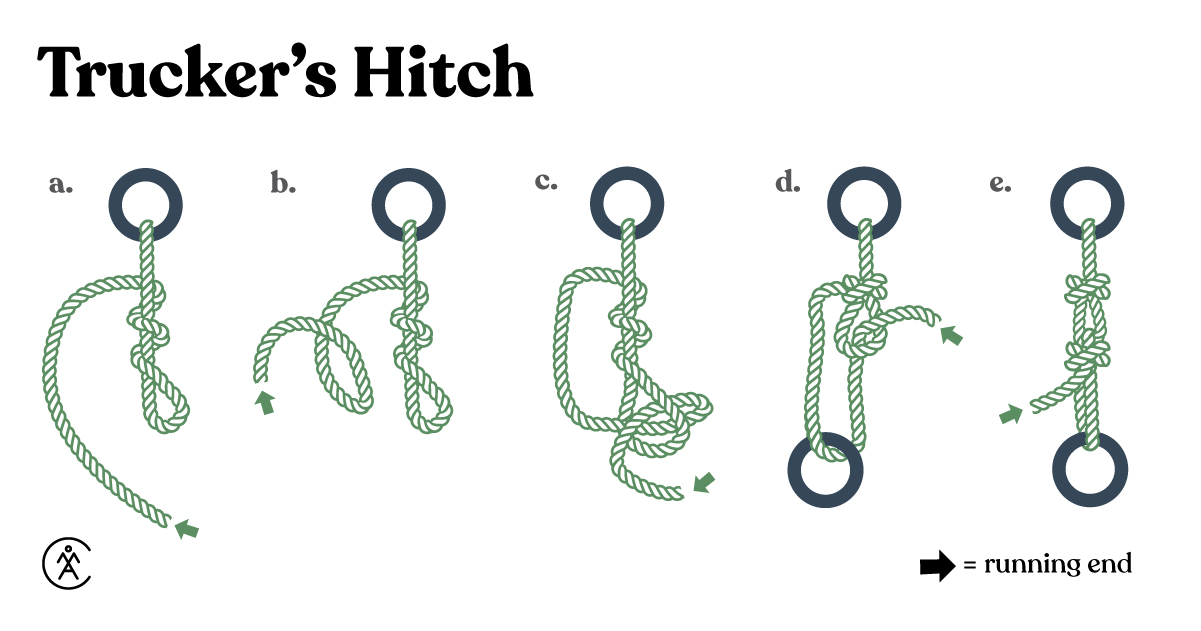

Clove Hitch
The clove hitch is another very useful knot that can be created anywhere along the middle part of the rope. Like any other good hitch, the knot will need to be cinched around an object to keep its form. Use a trekking pole to practice this knot.
- Pass the running end around an anchor point (your trekking pole).
- Pull the running end up, over the anchor point, to form an X across the standing end and the anchor point, pulling the running end down so that it’s parallel to the standing end.
- Lift the X part of the knot and slip the running end under this X vertically.
- Pull the knot tight.
Now, you have two strands of rope that are firmly secured to an object. This knot is very useful when setting up a lean-to-style tarp.
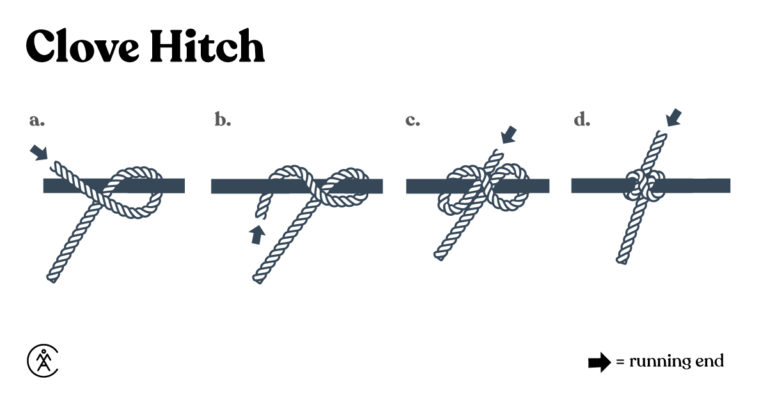

Want to learn outdoor skills from the pros? Join out workshops & adventures with AMC’s Guides.
Taut Line Hitch
The taut line hitch is another very popular knot for setting up a shelter. A bit like the trucker’s hitch, the taut line can create and sustain tension on a rope. Note that this hitch can loosen if tension is not maintained. To make the taut line hitch:
1. Pass the running end of the rope around an anchor point, such as a tent stake.
2. Coil the running end twice around the standing line, working back toward the tent stake.
3. Make one additional coil around the standing line on the outside of the coils you just made.
4. Pass the running end through the loop created on the outside of the coils. Tighten the knot and slide it on the standing line to adjust tension.
5. A great variation to this knot is to place a bight instead of the running end on the last coil. This gives you a slippery knot, allowing you to quickly undo the taut line hitch if needed.


BEND FAMILY
Square Knot
The square knot is the easiest knot to screw up. Many people trying to tie a square knot end up with a granny knot, which is quite different and quite useless. While the square will hold two ends of rope together, the granny knot will roll on itself and most likely come undone. The square is often used to tie cravats in first aid or to join two ropes or cords, such as when extending a rope for a shelter.
- Hold the running ends of the same rope or the running ends of two different ropes, one in each hand, then cross them by placing the running end in your left hand over the running end in your right hand.
- By doing the above, you will end up having to hold each running end with the opposite hand. Cross the running ends again, this time by placing the strand in your right hand over the strand in your left hand.
- Pull the running ends away from each other. You have now tied a square knot. You will know your knot is correct when you see that both running ends are parallel to their respective standing ends.
To remember this knot, memorize this catch phrase: “Left over right and right over left.”
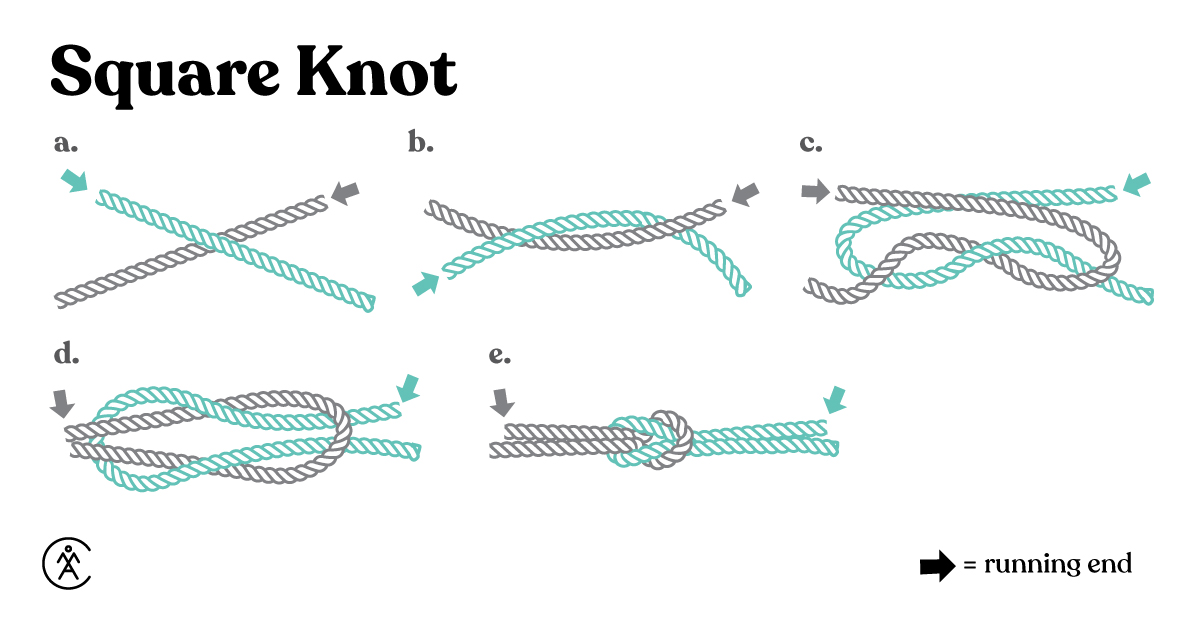

Want to learn more outdoor skills? Check out AMC’s Mountain Skills Manual.